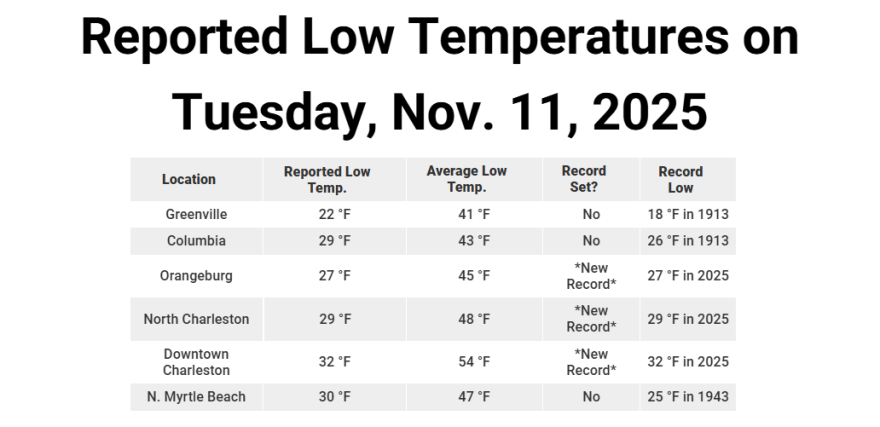The first widespread freeze of the season, with even a few brief snow flurries along the North Carolina border and parts of the Grand Strand, has officially brought an end to the growing season across the Palmetto State, according to National Weather Service meteorologists.
Temperatures on Tuesday morning reached nearly 20 degrees in Greenville, with most of the state reporting readings between 27 and 31 degrees, marking the coldest temperatures since last winter.
In Orangeburg, the overnight temperature dropped to 27 degrees, setting a new daily record low, and farther south, weather observation sites across Charleston also dipped into record territory for November 11, with temperatures reaching around the 32-degree mark.

While seeing a freeze in mid-November is not particularly unusual, this cold snap was more intense than typical, which contributed to the record-breaking values across the South.
The deep plunge was only a one-night affair, as winds were able to change direction to allow for a more modified air mass to settle into the region.
As a result of the freezing temperatures, the NWS will no longer issue Frost Advisories, Freeze Watches or Freeze Warnings for the remainder of the fall and winter months.
If this winter turns out to be a typical season, South Carolinians east of Interstate 95 will see a dozen or more additional freezes, with those in the Upstate, including Greenville and Spartanburg, experiencing more than 40 events.

The large variance in temperatures means there are four distinct growing zones across the state, with plants that are considered to be more delicate growing along the coast, with the hardiest varieties more inland and throughout the higher elevations.
Despite the recent chill, not all plants are done for the year, as some varieties can thrive through the winter, provided they are properly cared for.
“On my farm, we’re getting ready to plant delphiniums, snapdragons, poppies and a variety of others,” said Alexis Rehbaum, owner of Wild Goose Flower Farm in Moncks Corner, just outside Charleston.
Plants such as sweet peas, tulips, daffodils and Lenten roses can also grow during the colder months, though horticulturists note they require care in order to thrive in winter conditions.
For plants that don't do well during the cold, the official growing season will commence again on March 1, 2026, which is the date that NWS offices will begin issuing frost and freeze products for late-season cooldowns.
🥶It was COLD this morning across the forecast area! Here is a summary map of minimum temps this morning. This hard freeze has ended the growing season across the forecast area, so we will no longer be issuing Frost/Freeze Products until the Spring! #scwx #gawx pic.twitter.com/ytQ7lLi2nK
— NWS Columbia (@NWSColumbia) November 11, 2025


